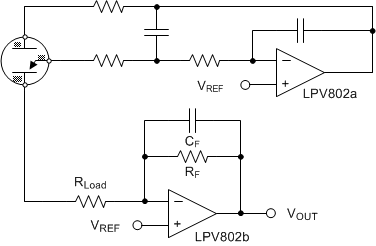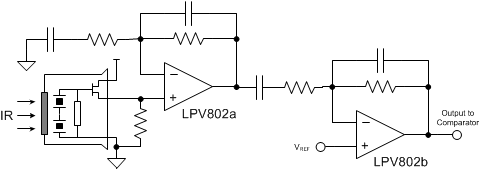SNOSCZ3B August 2016 – November 2016 LPV801 , LPV802
PRODUCTION DATA.
- 1 Features
- 2 Applications
- 3 Description
- 4 Revision History
- 5 Pin Configuration and Functions
- 6 Specifications
- 7 Detailed Description
- 8 Application and Implementation
- 9 Power Supply Recommendations
- 10Layout
- 11Device and Documentation Support
- 12Mechanical, Packaging, and Orderable Information
Package Options
Mechanical Data (Package|Pins)
- DBV|5
Thermal pad, mechanical data (Package|Pins)
Orderable Information
1 Features
- Nanopower Supply Current: 320 nA/channel
- Offset Voltage: 3.5 mV (max)
- TcVos: 1 µV/°C
- Unity Gain-Bandwidth: 8 kHz
- Wide Supply Range: 1.6 V to 5.5 V
- Low Input Bias Current : 0.1 pA
- Unity-Gain Stable
- Rail-to-Rail Output
- No Output Reversals
- EMI Protection
- Temperature Range: –40°C to 125°C
- Industry Standard Packages:
- Single in 5-pin SOT-23
- Dual in 8-pin VSSOP
2 Applications
- CO and O2 Gas Detectors (TIDA-00854)
- PIR Motion Detectors (TIDA-00489)
- Ionization Smoke Alarms
- Thermostats
- IoT Remote Sensors
- Active RFID Readers and Tags
- Portable Medical Equipment
3 Description
The LPV801 (single) and LPV802 (dual) comprise a family of ultra-low-power operational amplifiers for sensing applications in battery powered wireless and low power wired equipment. With 8kHz of bandwidth from 320nA of quiescent current, the LPV80x amplifiers minimize power consumption in equipment such as CO detectors, smoke detectors and PIR motion detectors where operational battery-life is critical.
In addition to being ultra-low-power, the LPV80x amplifiers have CMOS input stages with typically femto-amp bias currents. The LPV80x amplifiers also feature a negative-rail sensing input stage and a rail-to-rail output stage that is capable of swinging within millivolts of the rails, maintaining the widest dynamic range possible. EMI protection is designed into the LPV80x in order to reduce system sensitivity to unwanted RF signals from mobile phones, WiFi, radio transmitters and tag readers.
Device Information(1)
| PART NUMBER | PACKAGE | BODY SIZE |
|---|---|---|
| LPV801 | SOT-23 (5) | 2.90 mm x 1.60 mm |
| LPV802 | VSSOP (8) | 3.00 mm × 3.00 mm |
LPV8xx Family of Nanopower Amplifiers
| PART NUMBER | CHANNELS | SUPPLY CURRENT (Typ/Ch) |
OFFSET VOLTAGE (Max) |
|---|---|---|---|
| LPV801 | 1 | 450 nA | 3.5 mV |
| LPV802 | 2 | 320 nA | 3.5 mV |
| LPV811 | 1 | 450 nA | 370 µV |
| LPV812 | 2 | 425 nA | 300 µV |
Nanopower Amplifier in Electrochemical Sensor

Nanopower Amplifier in PIR Motion Detector
